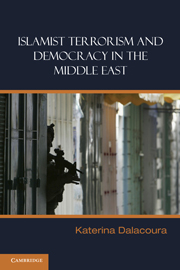Book contents
- Frontmatter
- Contents
- Acknowledgements
- Introduction: The Book's Central Question and Rationale
- 1 Terrorism, Democracy and Islamist Terrorism
- 2 Transnational Islamist Terrorism: Al Qaeda
- 3 Islamist Terrorism and National Liberation: Hamas and Hizbullah
- 4 Islamist Terrorism in Domestic Conflicts: The Armed Islamic Group in Algeria and the Gamaa Islamiya in Egypt
- 5 Moderation and Islamist Movements in Opposition: The Jordanian Muslim Brotherhood/Islamic Action Front, the Egyptian Muslim Brotherhood and the Tunisian Nahda
- 6 Islamist Moderation and the Experience of Government: Turkey's Welfare and Justice and Development Parties and the Islamic Republic of Iran
- Conclusion
- Bibliography
- Index
2 - Transnational Islamist Terrorism: Al Qaeda
Published online by Cambridge University Press: 05 June 2012
- Frontmatter
- Contents
- Acknowledgements
- Introduction: The Book's Central Question and Rationale
- 1 Terrorism, Democracy and Islamist Terrorism
- 2 Transnational Islamist Terrorism: Al Qaeda
- 3 Islamist Terrorism and National Liberation: Hamas and Hizbullah
- 4 Islamist Terrorism in Domestic Conflicts: The Armed Islamic Group in Algeria and the Gamaa Islamiya in Egypt
- 5 Moderation and Islamist Movements in Opposition: The Jordanian Muslim Brotherhood/Islamic Action Front, the Egyptian Muslim Brotherhood and the Tunisian Nahda
- 6 Islamist Moderation and the Experience of Government: Turkey's Welfare and Justice and Development Parties and the Islamic Republic of Iran
- Conclusion
- Bibliography
- Index
Summary
The lethal attacks on the US embassies in Kenya and Tanzania in August 1998 and against the Twin Towers in New York and the Pentagon complex in Virginia on 11 September 2001 catapulted al Qaeda onto the global scene and made it the most prominent Islamist terrorist actor of recent times. This prominence has led to a tendency to associate Islamist terrorism exclusively with it. It has also led to the widespread assumption that Islamist terrorism now operates, more often than not, in a transnational fashion. Neither is accurate. This will become evident in Chapters 3 and 4 which focus on Islamist movements, other than al Qaeda, that employ terrorist tactics while remaining firmly embedded in their respective domestic contexts. Furthermore, although other Islamist terrorist entities do operate transnationally, Islamist terrorism is not epitomized by any one movement or manner of operation. Al Qaeda's particular type of transnational Islamist terrorism deserves consideration in the context of this study because of its major impact on contemporary world politics, magnified by the US government's decision after 2001 to wage a ‘war on terror’.
The inclusion of al Qaeda in a book on the Middle East may seem out of place given that Pakistan and Afghanistan are more closely associated with its emergence and remain its hub at least at the time of writing (2010). The movement's impact has also reached Africa, South Asia, South East Asia and Europe, as well as the North American continent.
- Type
- Chapter
- Information
- Islamist Terrorism and Democracy in the Middle East , pp. 40 - 65Publisher: Cambridge University PressPrint publication year: 2011



